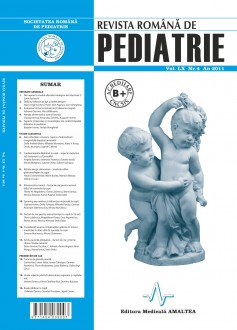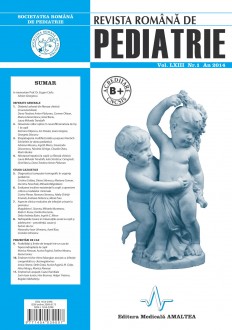SELECT ISSUE

Indexed

| |

|
|
|
| |
|
|
|

|
|
|
|
|
|
|
HIGHLIGHTS
National Awards “Science and Research”
NEW! RJP has announced the annually National Award for "Science and Research" for the best scientific articles published throughout the year in the official journal.
Read the Recommendations for the Conduct, Reporting, Editing, and Publication of Scholarly work in Medical Journals.
The published medical research literature is a global public good. Medical journal editors have a social responsibility to promote global health by publishing, whenever possible, research that furthers health worldwide.
The frequency of urinary tract infections in children with antenatal hydronephrosis
Delia Andreia Bizim, Mihaela Munteanu, Radu V. Russu, Ovidiu Brumariu and Ingrith C. Miron
ABSTRACT
Infants with antenatal hydronephrosis are at risk 12 times greater of developing acute pyelonephritis. We evaluated the frequency of urinary tract infections (UTI) in a group of 87 patients with congenital hydronephrosis (HN) detected antenatally (ratio B: F = 2,95:1). The average follow-up was 20.22 months. 49.42% of children had UTI, the recurrence rate (≥ 2 episodes) was 53.8%. Depending on the degree of hydronephrosis, urinary infection rate was between 37.5 to 41.37% for grade I-II HN and between 57-71% for grade III-V HN (p = 0.0402, 95% CI grade I-II HN compared with grade III-V). We found a weak positive correlation between the degree HN and the number of UTI (rs = 0.224, p = 0.036, 95% CI) significant statistic. 60.52% of patients with a history of UTI had urinary infections on uroprophylaxis. Cefaclor was the most common used antibiotic. E coli was involved in 36.35% of UTI, and Klebsiella pn. 25%. Given the high frequency of urinary infections in this group, it is neccesary a longer follow-up of these children for early detection of kidney damage.
Key words: congenital hydronephrosis, urinary tract infections, uroprophylaxis, antenatal diagnosis, UTI reccurence, antenatal hydronephrosis

